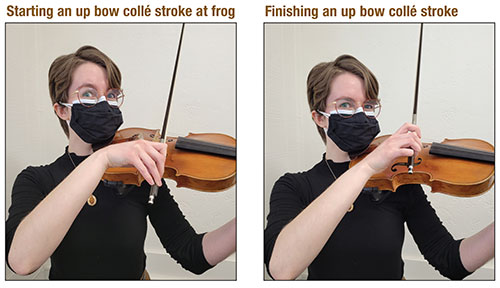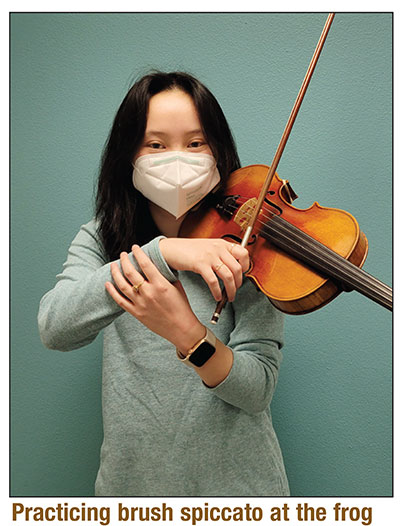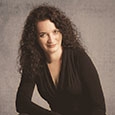The bow arm is responsible for sound quality, dynamic nuance, tone color, and many aspects of phrasing, articulation, and expression. Yet most string players spend more time thinking about and practicing their left-hand technique than their right-hand technique. Players need to learn many notes to keep up with ensemble work and perform solo repertoire. Since even a novice listener can identify poor intonation, string players work hard on left-hand position to clean up pitch problems. As a result, many students develop a sophisticated left-hand technique but play with a weak tone and struggle with off-the-string strokes. Imagine if players invested as heavily in their right arms. A review of essential bow strokes can jumpstart right-arm awareness, and players who incorporate daily bow-arm practice will be amazed at the transformation in their sound and expressive possibilities.
Before starting right-arm practice, check the bow to make sure everything is clean and functional. Rosin the bow and invest in a bow rehair if needed. Remind students not to touch the bow hair since the oil from their hands will stick to the bow and transfer to the strings, leading to slick parts of the bow. Check the tightness of bow hair. In the middle of the bow, the space between the stick and hair should be about the size of a fingertip.
Next, review the ideal bow grip. On the violin, the tip of the ring finger sits on the eye of the frog, and the other fingers drape over the frog. The thumb is underneath the stick and usually rests across from the middle finger. All of the fingers are bent. Students who struggle to keep fingers bent or relaxed can discover a natural grip by picking up and bouncing a tennis ball with their palms facing the ground.
Detaché
Detaché consists of a separate bow for each note, and each stroke connects to the next. The strokes are smooth, and the weight of the stroke stays consistent. Detaché can be played in any part of the bow, with any length of stroke, and with different bow speeds. Although detaché is usually the first bow stroke a string player learns, it offers many practice possibilities. Keep the bow parallel to the bridge and practice detaché at the frog, middle, and tip. Identify the ideal sounding point for each string, with the bow closest to the bridge on the highest string. Evaluate the bow grip: are all of the fingers (including the thumb) bent and relaxed? Practice ten-second bows and build up to thirty-second bows, with the sound staying focused and pure.
Slurs
Once players are confident playing separate bows with one note per bow, they can start practicing multiple notes in a bow. Use a sticky note to divide the bow into two even parts. Begin with two-note slurs where the second note aligns with the sticky note. They should try to keep the bow moving and deep in the string while changing pitches with the left hand. For students who are already able to execute two-note, three-note, and four-note slurs, incorporate asymmetrical slur patterns. For example, try a two-note slur on a down bow and a three-note slur on the up bow. Practice unusual numbers of slurred notes: five, seven or eleven notes on a bow. Practice slurred string crossings to gain flexibility in the right hand.
.jpg)
Martelé
Martelé, which translates to “hammered,” is a powerful, percussive bow stroke that consists of a sharp attack followed by a quick release. It can be notated in several different ways. Martelé is type of detaché, since there is only one note per bow, and the stroke can be played in any part of the bow and with any amount of bow.
.jpg)
To practice this stroke, place the bow on the string near the frog and allow natural arm weight to enter the stick of the bow. Some players like to engage the right index finger to gain a firmer grip on the string. Once the bow is completely attached to the string, initiate a down bow with fast bow speed while releasing the pressure that is in the bow. The result is a crisp, biting attack followed by a release into a clear tone, or a sharp consonant relaxing into an open vowel.
Each martelé stroke takes time to prepare, so practice it at a slow speed with spaces between all notes. This bow stroke cultivates clarity and articulation, but the fast bow speeds can send the bow spinning over the fingerboard. Practice in front of a mirror to maintain a beautiful bow lane and sounding point.
Staccato
When playing staccato, create space between each short (one to three inch) bow stroke. Separate bow staccato (one note per bow stroke) starts with a pinch like the martelé, but with less force. To set up a clear attack, place the bow on the string at the middle of the bow and dip the stick of the bow toward the string. Use right-hand flexibility to release from the dipped position into a clean stroke. Practice multiple staccato notes on a single bow, or “slurred” staccato, to work on bow division and clarity in all parts of the bow.
.jpg)
Add weight with the index finger to achieve a powerful sound in the upper half of the bow. To develop coordination, alternate slur and staccato practice. Play six staccato notes on a down bow followed by six slurred notes on an up bow. Try asymmetrical patterns like five notes slurred on a down bow followed by three staccato notes on an up bow.
Collé
In collé, the right-hand fingers execute short bow strokes. Collé can be played in many different parts of the bow but is usually practiced in the lower half. Practicing up-bow collé at the frog leads to greater control over bow changes, a wider range of off-the-string strokes, and a natural approach to playing chords. Set the bow at the winding near the frog. Keep the bow grip neutral, where the fingers are not completely straight or completely bent. Bend the fingers in a quick, energetic motion while initiating an up-bow stroke. By the end of the quick stroke, the fingers are completely bent and the right-hand knuckles are flat. Players often describe this motion as picking or scooping notes out of the string. (See pictures below.)

Practice up-bow collé in 3/4 at quarter note = 100. Play the collé stroke on beat one, release the fingers on beat two, and reset on beat three. Collé involves intense finger action, so young players may find that their pinky fingers get tired. If this happens, they can practice collé without the instrument. Point the tip of the bow toward the ceiling and practice bringing the frog into the hand and then releasing it toward the floor.
Brush Spiccato
Spiccato is a bouncing bow stroke where the hair of the bow leaves the string between each note. String players are required to play spiccato at many different speeds. Fast spiccato strokes work better higher in the bow than slow spiccato strokes. The brush spiccato is a heavy, slow-speed stroke that works best near the frog.
Start by placing the bow on the open A string about two inches above the winding at the frog. Wrap the left hand around the right forearm to stabilize the bow arm and isolate hand motion. Practice down and up bows (about two inches per stroke), using the left hand to silence extra motion in the right arm. Some players like to practice this stroke with their elbows against the wall to remove inefficient motions.

Once the right hand is able to control on-the-string strokes near the frog, increase speed and see if the bow begins to bounce. Some players visualize that they are tracing the bottom of a bowl with their right hands, creating a U-shaped bow stroke. Practice brush spiccato with two, three, or four repetitions of each pitch before moving to the next note. Advanced players can practice asymmetrical spiccato patterns: two repetitions of the first pitch followed by three repetitions of the second pitch.
Sautillé
Sautillé is a very fast spiccato bow stroke that works best just below the middle of the bow. In this stroke, the bow hair itself may not actually leave the string, but the flexibility of the stick makes it sound like the bow is bouncing. Practice this stroke slowly and completely on the string at first. Set the bow on the D string one inch below the middle. Practice open D to open A string crossings in various patterns, allowing the right hand to articulate the strokes.
.jpg)
Keep the right elbow and forearm stable, relaxed and heavy, and let the right hand dance at the end of the arm. Gradually increase speed and redirect the bow to one string. If the bow hair is flat, the right hand fingers are bent, and the bow is moving very quickly in small (one-inch) bow strokes, the stick of the bow should start to bounce.
Ricochet
This fun bow stroke is one of the only strokes that starts from above the string. Ricochet relies on the natural bounce of the stick. Multiple notes bounce on one bow stroke, but the player only instigates one impulse. Ricochet is much easier to play down-bow, and ricochet passages in repertoire usually consist of two, three or four notes on a down bow followed by a single note on an up bow.
.jpg)
Ricochet requires experimentation. Students should start with the bow one to two inches above the string in the middle of the bow. Let the bow drop to the string while initiating a down bow motion. See how many bounces come out of that initial bow drop. Then try starting two to three inches above the string to see how many bounces come out from that altitude. Players will quickly discover how high to start above the string and how much bow to use for a two-note, three-note, or four-note ricochet. Ricochet sounds best right in the middle of the bow with very flat bow hair (no bow tilt), and the bow parallel to the bridge.
Practicing each of these bow strokes with open strings is useful and important, but it is a lot more fun to practice bowings with scales or etudes. Since string students learn the keys of D, G, A, and C first, prioritize scales in flat keys. Many young players have not learned a chromatic or whole tone scale, so working on these new scales with a variety of bowings is a great way to multi-task left-arm and right-arm practice. Whatever pitches you choose, daily right-arm practice develops a better tone, creates a wider tonal palette, and opens the door to a plethora of different articulations and expressive tools.






